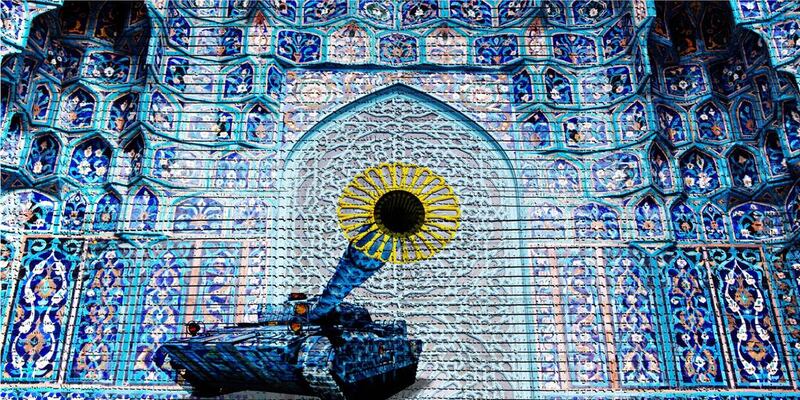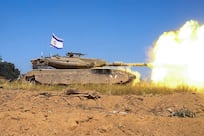In his artist’s statement for his latest exhibition, Al Sahwa (The Awakening), Abdulnasser Gharem announces a forceful battle for the future of the Muslim world.
“I have attempted in this exhibition,” he writes, “to magnify all that I have previously mentioned, hoping to launch a request for the restoration of the real Islam, which believes in pluralism and diversity and together is committed against extremism.”
It is a powerful message and one that he brings home time and time again in the artworks hanging in Ayyam Gallery’s smallest UAE branch in Dubai International Financial Centre (DIFC) until the end of the month.
Take Camouflage as an example. The large 2.4 x 4.8 metre rubber-stamped print depicts an army tank with a sun firing from its gun arm exploding in the centre of a mihrab – the wall niche commonly found inside a mosque to indicate the direction of prayer. It is a visual impact of what Gharem, a lieutenant colonel in the Saudi Arabian army, sees all around him.
“What is happening on the ground is camouflage,” he says. “These theocratic countries are using people’s values to tell them there will be a great future of Islam but in fact they are the victims.”
Gharem says that the motivation for this exhibition came after he realised that he himself was one of the victims.
He describes his childhood when a fundamentalist group called Al Sahwa began to form in his primary school classes and then later as it gained traction, its members began to recruit students through a campaign of controlling grades.
“By controlling grades they controlled us,” he says. “Unless you joined their group they would not give you high grades so because we were under pressure from our families to do well in school, we joined the group.”
But what the group promoted was aggression and hostility towards any other faith and it also encouraged conflict against other groups within Islam with different opinions, such as Shia or Sufi or other schools of thought.
Rather than express this directly, Gharem has chosen the visual language of art to express the devastating effects this had and continues to have on his generation.
In Pause, the rubber stamps are made in the same colour and form as road markings, but look again and the two vertical lines, which could also resemble a pause button, have a small airplane flying into the side of them – and so represent New York’s World Trade Center towers.
“9/11 was a pause for the whole world,” Gharem explains. “Nobody knew what to do. I believe this was a result of these kinds of groups and with this piece of art I am taking my chance to show the people my ideas. They need to know us through this, not through the media.”
There is a map on the wall, titled No More Tears, which is part of a series that he has been developing since 2009. In this 2014 version, Gharem displays the divisions in the region based on Islamic sects. He is using the slogan to underline his usual plea for harmony.
“I am showing the people that the solution is not to be divided – it is to be living together. I am asking them to wake up.” And so, in a reversal of the meaning of original title of the extremist group, Gharem is using the word to link all the pieces in this show.
In the front window is an image that has become the poster piece for the show. Hemisphere shows a dome, which on one half is a major mosque and on the other half is a warrior’s helmet.
“With this one I am asking why they made me into a warrior, who did they want me to fight? It is all about trying to control people’s minds,” he says.
The battle Gharem is fighting with his art is one for peace. Within one artwork, amid the hand-laid rubber stamps, is this phrase: “If we could all stand for each other and have nothing to hide, then we can all sit down together and have nothing to fear.”
Maybe it is a pipe dream, but you have to give Gharem one thing – at least he is trying to say it.
• Al Sahwa (The Awakening) runs at Ayyam Gallery in DIFC until Wednesday. Visit www.ayyamgallery.com for more information
Anna Seaman is The National’s visual arts writer.
[ aseaman@thenational.ae ]





